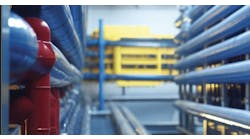The basic Aspirating Smoke Detection (ASD) system has three main components:
- A sampling pipe network, which collects air through sampling holes and transports it from the protected space to the detector, where it’s tested for the presence of smoke particulate.
- An aspirating smoke detector constituted of 1) a sensing chamber with a high sensitivity sensor to detect smoke particles suspended in air; 2) an aspirator or fan to draw air from the protected area to the sensing chamber; 3) an optional filter to remove all large particles that may damage the sensor within the sensing chamber.
- The exhaust pipe to expel the sampled air from the detector.
Air aspirating smoke detector sampling CPVC pipe is used in ASD systems to transport air samples from smoke detectors to a central control panel. The pipe is made of chlorinated polyvinyl chloride (CPVC), a material that is highly resistant to corrosion and degradation caused by exposure to heat and moisture. The pipe is also designed to maintain a constant air flow rate, which is crucial for accurate smoke detection.
NFPA 72 Chapter 17.7.4.6 Air Sampling-Type Smoke Detection is a standard outlining the requirements for the installation, testing, and maintenance of smoke detection systems in buildings. Specifically, Chapter 17.7.4.6. focuses on the requirements for air sampling-type smoke detectors that are connected to the ASD control panel.
According to NFPA 72, smoke detection sampling CPVC pipe must be used to ensure accurate and dependable smoke detection. This type of pipe helps to prevent contamination of the air samples and ensures a consistent airflow rate.
Contamination of the air sample can occur if the pipe is made of materials that react with or absorb the components of smoke, such as carbon monoxide, nitrogen oxide, and sulfur dioxide. If the air sample is contaminated, this can lead to false alarms or even failure to detect smoke, which can have catastrophic consequences in the event of a fire.
Consistent airflow rate is critical for accurate smoke detection because changes in airflow can affect the concentration of smoke particles in the air sample. Smoke detection sampling CPVC pipe is designed to maintain a constant airflow rate, which ensures that the smoke detector can accurately detect the concentration of smoke particles in the air sample.
In addition to the requirement for the use of smoke detection sampling CPVC pipe, NFPA 72 Chapter 17.7.4.6. also specifies labeling requirements for this type of pipe. These labeling requirements are designed to ensure that the pipe is installed and maintained correctly, and that it is easy to identify during testing and maintenance activities.
Pipe Labels
NFPA 72, FIA, and other recognized codes and standards require ASD pipes to be labeled in an effort to distinguish them from other piping, and to specifically identify them as a fire detection system component. Both the sampling pipe network and each individual sample hole need to be identified. The pipe and sampling holes should be labeled at the following locations:
- At changes in direction or branches of piping
- At each side of penetrations of walls, floors, or other barriers
- At intervals on piping that provide visibility within the space, but no greater than 61 m (20 ft)
- At each sampling hole.
The pipe shall be labelled with verbiage similar to “SMOKE DETECTOR SAMPLING TUBE: DO NOT DISTURB.”
NFPA 72 also specifies requirements for testing and maintenance of air sampling type smoke detection systems including regular testing of air sampling type smoke detectors, replacement of damaged or faulty components, and maintenance of records to document the testing and maintenance activities.
By following the requirements specified in NFPA 72 Chapter 17.7.4.6., building owners and facility managers can ensure that their air sampling type smoke detection system is functioning as intended, providing optimal protection against fires.
Holland Smith is General Manager – Alarm & Detection Portfolio at Viking Group. Viking SupplyNet, one of the industry’s leading distribution networks, provides ASD CPVC pipe in lengths of 10 and 15 feet, delivered in clearly marked bags for simple identification. ASD pipe from Viking also features clear markings for easy installation and maintenance. Visit supplynet.com today or contact your local rep for details.







